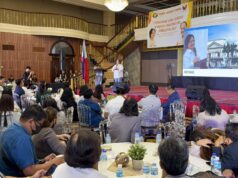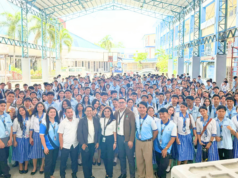CITY OF SAN FERNANDO – The City Tourism Office (CTO) here has dubbed it “Holy Week Spectacle in the Philippines”, a neatly packaged itinerary for media and tourists expected to troop here anew by the tens of thousands for the traditional Lenten practices in this province.
The itinerary is not only geographical, but also chronological, starting Holy Wednesday (March 27), particularly for media folk who need to first secure accreditation from the CTO before covering the events lasting five days, or up to Easter Sunday.
The first day is a sortie at 9 a.m. to Barangay San Pedro Cutud for “family immersion” with a flagellant and the “Kristo” or one of the penitents who could actually be crucified on wooden crosses in the same barangay.
The CTO itinerary said Maundy Thursday, whole day would be devoted to “pabasa” or “non-stop chanting of biblical verses in different makeshift chapels either in the City of San Fernando or Angeles City.”
“Witness the procession of flagellants along the way heading toward a chapel for their final journey and moment of prayer,” the itinerary said.
The main attraction is on Good Friday, starting at 7 a.m. again in San Pedro Cutud for the Via Crucis or Way of the Cross which CTO described as a “a 51- year- old street drama on the Passion of Christ written and performed by local residents.”
“At 12 noon, join thousands of people to witness actual crucifixion of a host of seven to 10 penitents. There’s an optional visit to Barangay Lourdes Northwest in Angeles City where another crucifixion takes place between 2 to 3 p.m.,” the CTO said.
CTO said that whole day on Black Saturday could be for “shopping for Kapampangan delicacies, arts and crafts in San Fernando, Betis (in Guagua town), San Matias (in Sto. Tomas town) and Mexico.”
“Easter Sunday at 4 a.m, proceed to Sta. Maria Parish Church Balibago, Angeles City to witness the most elaborate Salubong, a traditional religious event which portrays the meeting of Christ and His mother, Mary, after the resurrection in an elaborate drama participated in by local residents dressed as angels and different biblical characters,” the CTO said.
Another option for Easter Sunday starting at 8 a.m. is Sto. Tomas town “for a whole day festivity of religious events (salubong), street dancing (Sabuaga Festival), trade fair and variety shows including fireworks in the evening.”
“Witness their Sabuaga Festival featuring a showering of petals on the image of the Virgin Mary.
Petals and confetti will literally rain on the processional route around Poblacion, starting 2 p.m. as revelers join groups coming from the town’s seven barangays in street dancing,” the CTO said.
The CTO itinerary also provided a historical account on the Lenten practices here.
“The re-enactment of Christ’s crucifixion that is practiced each year in the City of San Fernando originated in 1955 with the staging of Via Crucis , the only Kapampangan piece on the passion of the Christ written by an amateur, Ricardo Navarro.
It was first performed during the Holy Week (in 1955) by an amateur volunteer artists of Barangay (barrio) San Pedro Cutud, who like the rest of the Filipinos during that period, had time on their hands because work or exertion on those holy days was taboo.”
It noted that “it was only in 1962 that the barangay first witnessed an actual crucifixion during the play.
The Christ was potrayed by Artemio Anoza, a resident of nearby Apalit town and a quack doctor who dreamt that he would become a religious leader and full-fledged healer. Wanting to realize this dream, he volunteered himself to be crucified as a sacrifice.”




